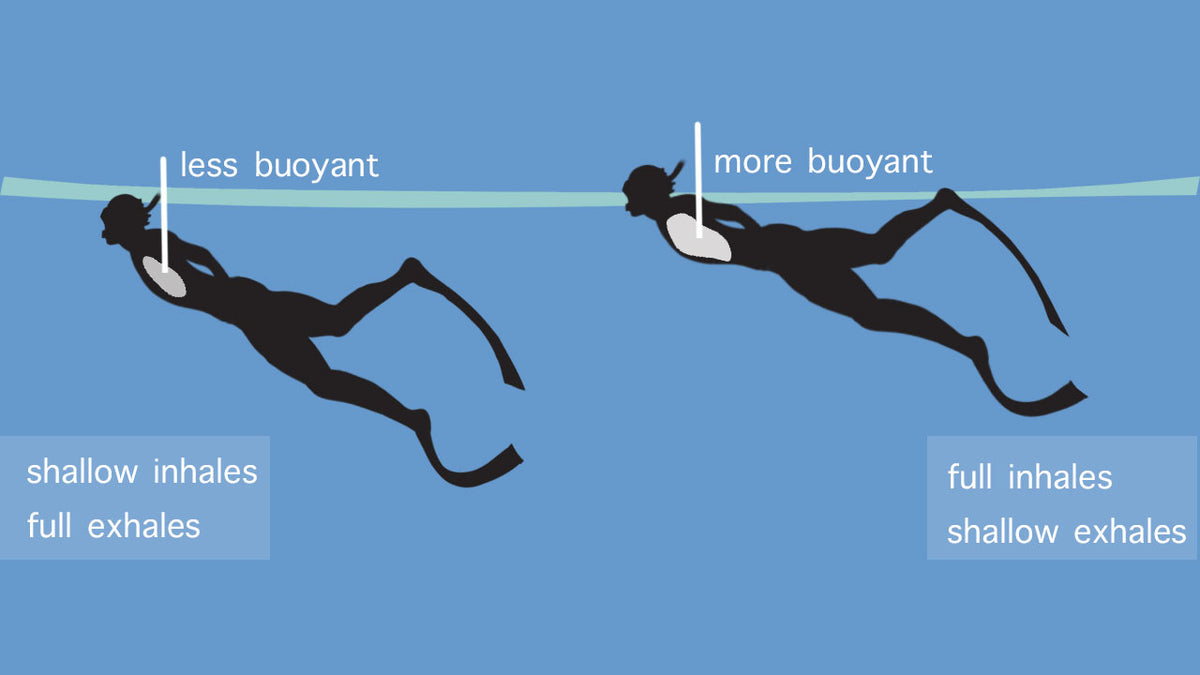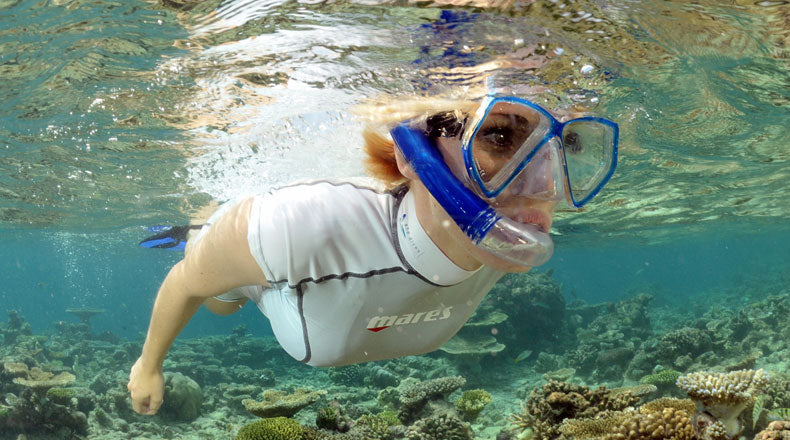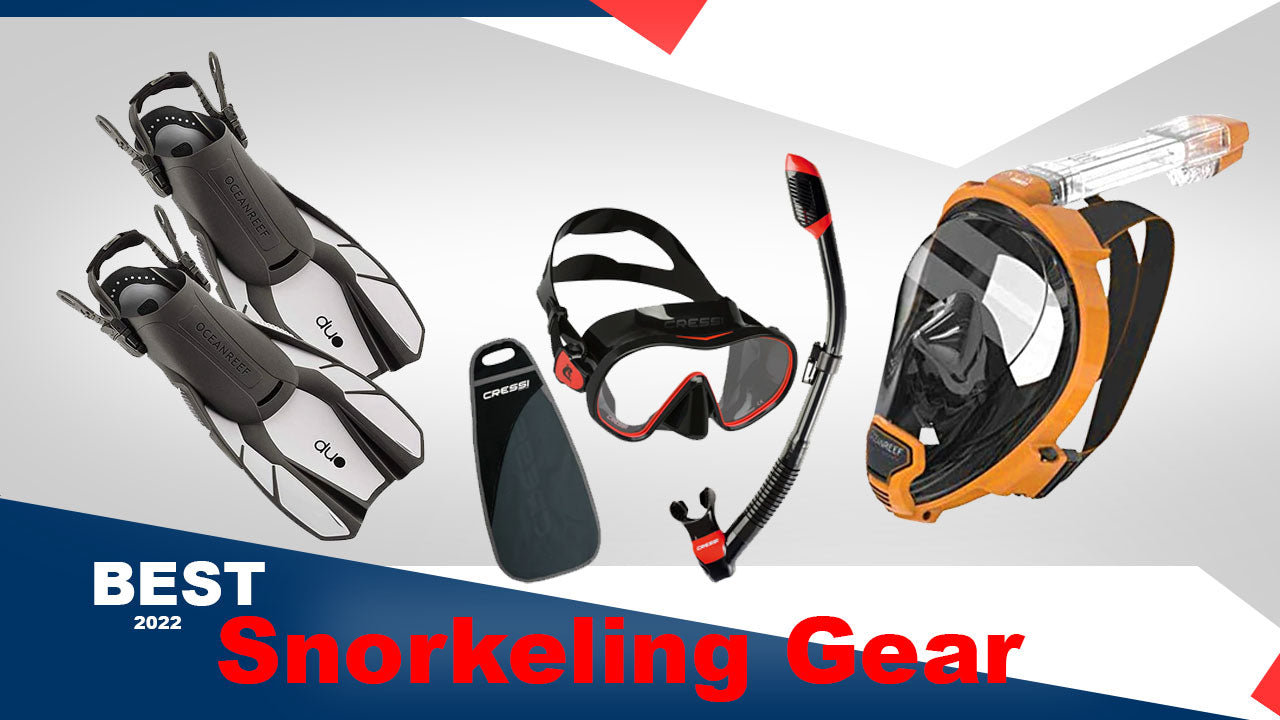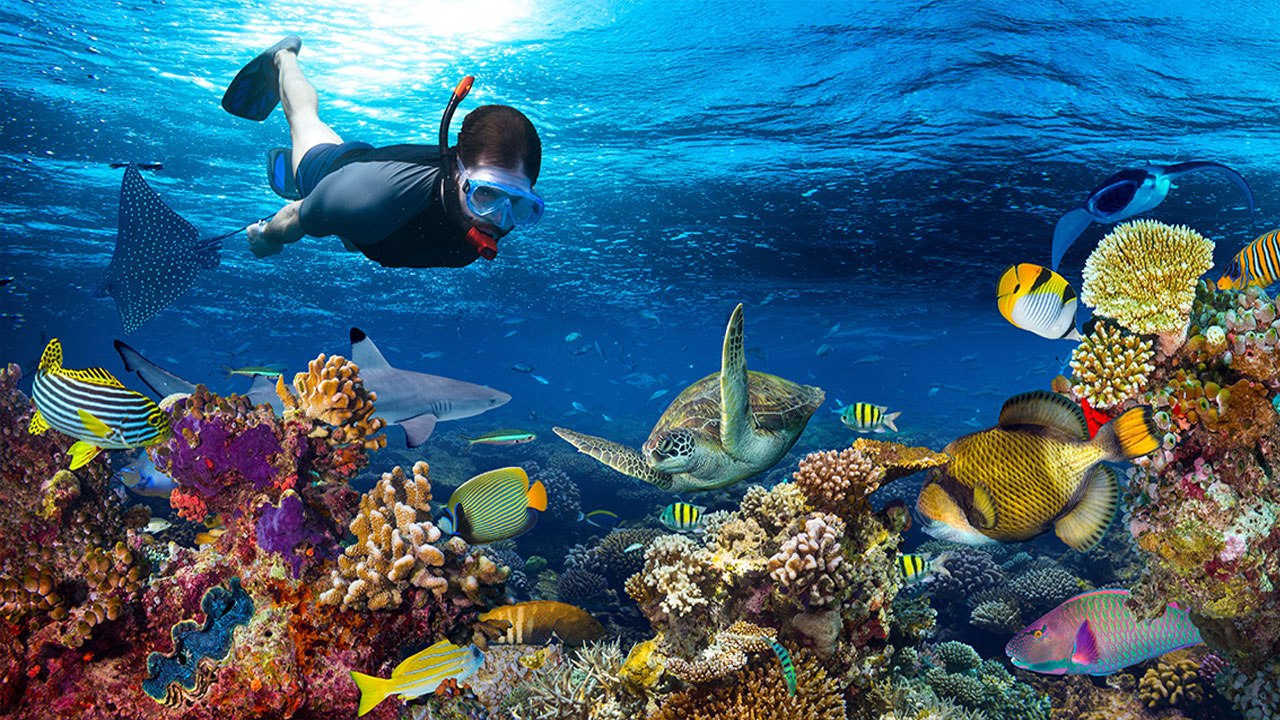Improving Your Snorkeling Skills - 10 Ways to Become a Snorkeling Pro

Your next vacation is just around the corner and you are excited about your new snorkeling adventures. You have already found the perfect location with amazing beaches and calm water. You have chosen the right snorkeling equipment and learned some basic mask and snorkel skills. You are familiar with the responsible snorkeling guidelines but you’re still wondering - what else I can do to become a better snorkeler?
In this article, we have gathered ten useful tips that will help you take your snorkeling skills to the next level.
If you are just getting into snorkeling and want some advice on how to have an enjoyable experience and avoid common beginner mistakes, check out this article.
Top 5 Snorkeling Tips for Beginners
If you plan on purchasing a mask, snorkel, or a new pair of fins, take a look at our review of this year’s best snorkeling gear.
Best Snorkeling Gear in 2024 - a Complete Guide
1️⃣ Become a Better Swimmer
While snorkeling can be as simple as floating on the water’s surface and kicking with your fins from time to time, it can also be a bit more challenging, and exciting, as that. Whether you want to feel more confident in the water, be ready to respond to unexpected situations better, or plan to try some shallow freediving or snorkeling in mild current, improving your swimming technique will be of use.
You certainly don’t need to be a professional swimmer, and, while snorkeling, you will mostly use your legs for kicking. Nevertheless, you should also know how to use your arms effectively by learning a proper freestyle and breaststroke. This will be helpful if you’ll need to cover longer distances or require more power to swim against the current.
You should also practice swimming in your snorkeling gear. Take your fins, mask, and snorkel to your local pool to get used to them. A swimming board (kickboard) will be a helpful tool to master kicking with your fins on and strengthen your muscles. Place your hands and elbows on top of the board and swim around using only your legs.
Finally, to become an advanced snorkeler, consider taking a freediving class. You will understand why it may come in handy in the following three tips.
2️⃣ Improve Your Breathing Technique
Marine life is breathtaking, no doubt. But, despite being in awe of a fascinating view, you need to breathe correctly. Frequent short breaths will get you tired too quickly, while deep breathing allows you to investigate longer. Breathe in, filling the diaphragm first, then the chest, and, lastly, the very top of your lungs.
Practice deep breathing at home. Lay on your back, place your hands or a book on your stomach and notice how it moves up and down with every breath.
If you plan swimming below to depth to get a closer look at marine life, you should learn how to breath-hold. Remember that you should not hyperventilate before the dive. Continue breathing deep and slowly, then breathe in and hold your breath. In freediving lessons, you will learn more ways to improve your breath-hold.
3️⃣ Try Skin- or Freediving
Both skin diving and freediving involve submerging below the surface while holding your breath. The difference between the two activities is that freediving is mostly competition-oriented. It challenges you to explore your personal limits and requires more training and discipline. Skin diving is strictly recreational with short bottom times and shallow depths.
So, if you just want to swim down to observe interesting objects or marine life, some skin diving practice will be sufficient for you. In order to dive down efficiently, bend 90 degrees in your hips, putting your torso perpendicular to the bottom, then raise your legs until they are pointing straight up in the air. This way the weight of your legs will push you down and you won’t spend precious energy (and oxygen) on extra kicking. You will be able to start finning once your entire body is submerged. Don’t forget to equalize in the process! More on that in our next tip.
In order to freedive and progress in a way that is safe, read our article
10 Basic Safety Rules for Freedivers4️⃣ Learn to Equalize
If you are interested in doing some skin diving, learning to equalize is a must to prevent ear damage. There are many different techniques but the most common one is the Valsalva Maneuver, where you should pinch your nose and blow gently. If the maneuver is successful, you will feel your ears ‘clear’ and the pressure subside. Equalize early and often - before you feel any discomfort. If you have trouble clearing your ears, don’t force it, return to the surface.
Read more about equalization in our article
Ear Equalization Basics: Why and How5️⃣ Know What to Do in Case of Panic
Even if you are a good swimmer and generally feel comfortable in the water, a nasty surprise such as losing a fin, getting caught in a current, or having a leaking mask, can unnerve you. For the less confident snorkelers, one such event may be enough to lead to panic.
Being in a state of panic usually causes people to behave irrationally. That’s why it is important to prepare beforehand. If you already have some fears related to water, think about what makes you scared and create a plan of how you will deal with it.
Develop such action plans for each situation that might send you over the edge. Remember, if you can think rationally and remain calm, you will find a way out of almost any mishap.
What should you do though if panic does strike? First of all, learn to spot the signs of panic approaching early. Some of the symptoms to look out for are rapid breath or feeling as though you can’t get enough air, increased heart rate, chest tightness, nausea, tense muscles, tremors, feeling out of control, etc. If you find yourself experiencing any of the following while in the water, it’s likely that you’re reaching your limit and it’s time for a break.
Here are a few things you can do to help yourself calm down:
- Regulate your breathing. Try to slow and lengthen your breath, especially the exhale. Many snorkelers find a rhythm, count, or even a line from a song to help them breathe in a calm way. This will help you direct your attention away from panic and signal to your body that you’re ok.
- Talk yourself through it. Try to stay positive, and tell yourself that you are strong, capable, and fully in control. Remind yourself of the preparation you did beforehand.
- Remove the source of stress. If possible, try to solve the issue that led to panic. If you have developed an action plan for a situation like this, follow it step by step.
6️⃣ Practice Buoyancy Control
Buoyancy control is basically an ability to deliberately sink or float by adjusting your density and displacement. While this skill is extremely important for scuba divers, snorkelers can benefit from it too. Knowing how to precisely tune your position in the water will increase your confidence and enjoyment during snorkeling.
So how do you master your buoyancy? Your lungs are essentially a natural buoyancy control device. By inflating your lungs, you make your total volume larger without increasing your weight. This lowers your density, causing you to float. Therefore, if you want to rest comfortably on the surface, practice deep inhales with normal or shallow exhales in between. Conversely, when you need to lower yourself a bit, try shallow inhales and full exhales. When you do this, your body will most likely be completely submerged, and you will drift just under the waterline.
Remember, mastering buoyancy control takes time and practice, so it is a good idea to dedicate at least a few minutes to focus on your breathing and experiment with how it affects your buoyancy every time you’re in the water.
The gear you use can also affect your buoyancy. For example, a neoprene wetsuit will give you some additional flotation. The thicker the suit, the more buoyant it will be. That being said, a wetsuit cannot and should not be used instead of a personal flotation device.

7️⃣ Learn to Assess the Chosen Snorkeling Site
This skill is especially important if you are planning to explore independently, and not as a part of an organized group.
Tides, wind, atmospheric pressure and air temperature can all change sea conditions quickly and dramatically. So, you should learn about those factors beforehand. Check the weather forecast and tide charts for your chosen location in the days leading up to the activity and on the day you plan to snorkel. Additionally, you should visually assess the sea conditions upon arrival.
It is generally recommended to consider the following:
- the water surface should be calm with minimal or no chop;
- swell (unbroken waves) should be less than 4 feet (1.2 meters);
- stable weather conditions must prevail, with no obvious threat of a sudden change in weather that could significantly affect the safety of the activity.
Always inquire about the local sea and weather conditions before entering the water and, if in doubt, postpone your snorkeling.
It is also a good idea to check the ultraviolet index in your weather app. A high UV index requires extra sun protection, such as wearing a rash guard or wetsuit jacket and applying sunscreen (it is highly recommended to use reef-safe sunscreen). Additionally, try to avoid snorkeling during midday; better choose mornings and evenings.
If you plan to swim further from the shore, think about safety and ways of signaling your location for ships and boats (such as carrying signal tubes or warning flags).
Last but not least, it is recommended to assess the level of access to communications and external assistance, in the event of an emergency, or extreme weather conditions. The more remote the location is, the more self-reliant you must be, and this should be taken into account when planning the activity.
8️⃣ Know and Observe Local Laws and Regulations
There are areas where snorkeling can be completely or temporarily prohibited. For example, weather, sea conditions, the presence of jellyfish, sharks, or any other potential danger can be among the reasons to limit snorkeling. In such cases, there will, most often, be some sort of warning in place. Therefore, you should always follow the signs, flags, or buoys you see on your chosen snorkeling site.
If you go out of marked swimming areas, where permitted by law or local regulations, it is often mandatory to take a diver down flag with you.
You should also avoid going to boating or active water sports areas (surfing, windsurfing, jet-skiing, etc.) to avoid any risk of collision.
9️⃣ Work on Your Fish ID Skills
For most people, the main reason to go snorkeling is to see the fish and marine animals in their natural habitat. But the experience can be so much more rewarding if you know what exactly you are looking at.
Here are three simple tips that will help you with your fish ID skills:
- BEFORE: Get familiar with the common fish families (or just your favorites) and learn about their anatomy, size, habitat, and any other information you find interesting.
- DURING: In addition to looking at the fish’s appearance, note its behavior as well. What the fish is doing can be just as helpful as what it looks like when you are trying to identify it. Is it on its own or in a group? How does it swim and which fins does it use? Is the fish swimming at the surface, in the middle of the water column, or closer to the bottom?
- AFTER: Try to look for the fish you’ve seen in a fish ID book or on the web as soon after the snorkeling session as possible. Memories fade fast, especially when confronted with a page of 10 very similar-looking fish.
🔟 Follow Snorkeling Etiquette
Remember, as a snorkeler, you are a visitor in the environment you’re exploring, so, you should respect it and ensure that you do no harm. In our previous article, 5 Snorkeling Tips for Beginners, we have outlined the most important rules one should follow to be a responsible and eco-minded snorkeler. Let’s go over them briefly:
- Do not touch corals;
- Do not harass sea life;
- Do not feed fish or turtles;
- Do not use harmful sunscreen;
- Do not take anything home with you.
In addition to being respectful to marine animals though, you should also follow some basic snorkeling etiquette when it comes to your fellow snorkelers or swimmers. Here are a few simple pointers to keep in mind:
- Be aware of your surroundings. Observing the fascinating world beneath the waves is what snorkeling’s all about, yet you should also pay attention to what’s happening around you. Bumping into other snorkelers is likely to spoil the experience for you and them as well. This is why you’ll want to keep an eye on where other snorkelers and boats are to ensure both your and their safety.
- Do not ascend or descend right in front of someone if you are skin diving to take a closer look at the marine life.
- Respect other snorkelers’ boundaries. Try not to swim too close to other people and pressure anyone into moving spots, even if there is something very fascinating in that place. The ocean is open to everyone, and there’s plenty of beautiful fish to see for all!
We hope these tips will help you become an advanced snorkeler and make the most of this activity!






Great article! As a snorkeling enthusiast, I found these tips incredibly helpful. Your advice on mastering buoyancy and practicing proper breathing techniques really resonated with me. It’s amazing how much these small adjustments can enhance the overall snorkeling experience.
Thank you for sharing these valuable tips on how to become a snorkeling pro! As someone who enjoys snorkeling and is always looking to enhance my skills, your suggestions are incredibly insightful.